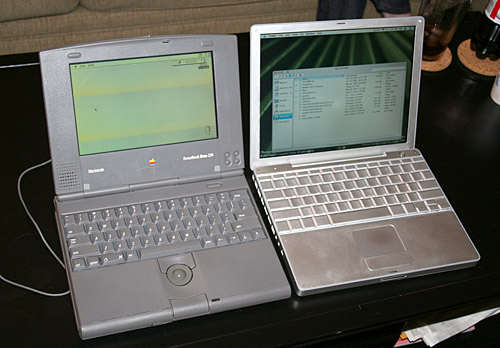This weekend, I finally got around to helping my brother get some files off of an old Powerbook Duo 230 that he’s been keeping in storage; I was pleasantly surprised that I was even able to get the laptop onto the internet. I’ve put a few photos up on Flickr, just for kicks.



I’d like to erase a hard drive as securely as is reasonable on a Mac 7100 (if you can believe it) and an 8600 before I donate them. Have any suggestions as to how?
• Posted by: Jeff on Jul 15, 2005, 4:38 PMYou could try Darik’s Boot and Nuke for erasing the drive, don’t know if it’ll work on that old computer though. There is a floppy version…
• Posted by: user on Jul 15, 2005, 6:09 PMMagnet
• Posted by: b on Jul 15, 2005, 6:59 PMDumb question, but how’d you do it? Just link the two with a serial cable and have the PowerMac recognize the Duo?
• Posted by: Adam on Jul 15, 2005, 7:14 PMAdam, I didn’t connect the machines directly to each other, but rather I put the Duo on the network — my brother still had his Newer Technology Ethernet MicroDock, and happily, the system still had all the drivers installed and functional. Unfortunately, the TCP stack (MacTCP) wasn’t able to get an address from the DHCP server (can you believe that the system was from before DHCP had achieved prevalence on networks?!?), so I had to configure the network addressing stuff manually. (I had forgotten how painful MacTCP was to configure.) After that, I was able to turn on the FTP server on my Powerbook G4 and then use Fetch (version 2.0!) on the Powerbook Duo to connect to it and transfer the files.
• Posted by: Jason on Jul 15, 2005, 8:19 PMJeff, if you just want to straight erase them, I’d find a cheap internal SCSI card for a desktop machine that you might have around (making sure that it has the low-density 50-pin connector, since that’s what both the 7500 and 8600 used), connect up the drives, and format ‘em securely using your current operating system.
It’s funny — we couldn’t get the monitor for my brother’s old PowerMac 7100/66 to work last weekend, and the connector on the computer didn’t let us use any other monitors, so I had to just take the drive out and throw away the computer. I’m going to do just what I suggested above, but before formatting the drive, I want to see if I can retrieve anything from it. It’ll be trickier since I’ll put it into my PC; I need to find software that’s good and reasonably inexpensive to access the Mac filesystem. We’ll see!
• Posted by: Jason on Jul 15, 2005, 8:36 PMJason, I’m not sure what you’re suggesting (re: connecting the drives). Could you explain a bit further?
While thinking about this, I did come up with an idea. I have a SCSI external hard drive. I downloaded Burn , which would securely destroy all the files I put in the trash (I don’t care about the system files).
I could just hook up the external hard drive to each computer and zap the HD.
• Posted by: Jeff on Jul 16, 2005, 10:27 AMThis id mine Mac, PowerBook 100
• Posted by: Goran AniÄić on Jul 22, 2005, 3:53 AM